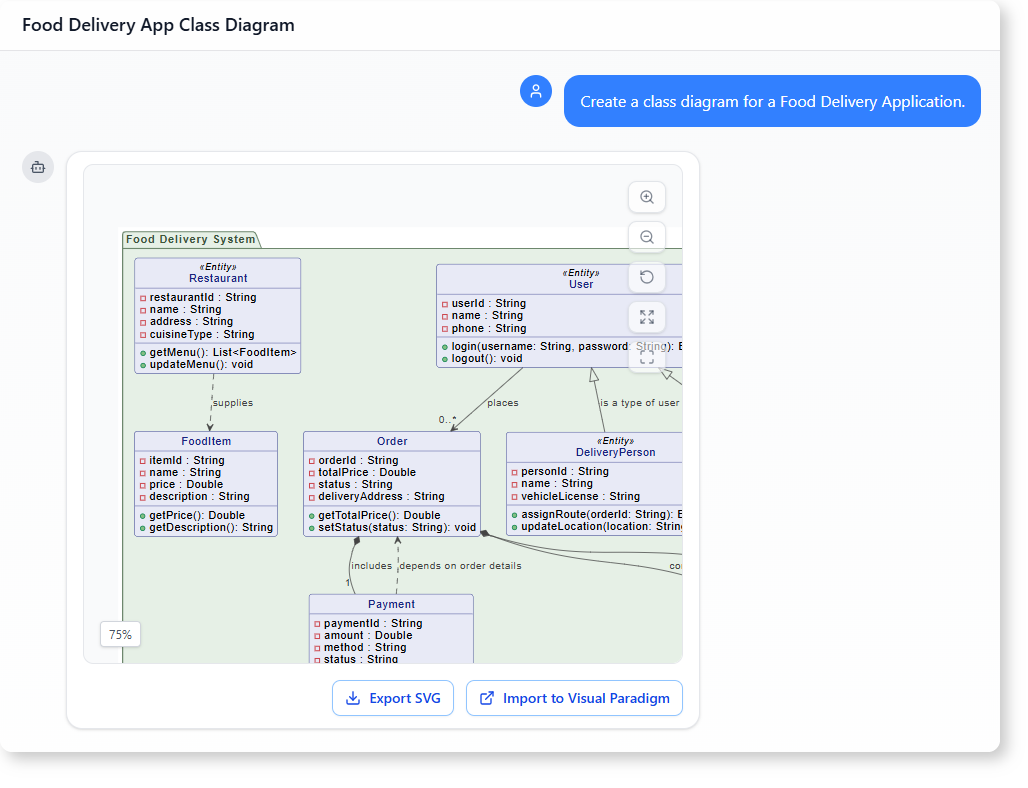Now Reading: How AI-Powered Modeling Software Builds a Food Delivery Class Diagram
-
01
How AI-Powered Modeling Software Builds a Food Delivery Class Diagram
How AI-Powered Modeling Software Builds a Food Delivery Class Diagram
How AI-Powered Modeling Software Builds a Food Delivery Class Diagram
Imagine you’re building a food delivery app. You need to map out the core components—users, restaurants, orders, payments—without spending hours drawing diagrams by hand. That’s where AI-powered modeling software comes in.
With just a simple prompt, you can get a clear, structured class diagram showing how data and responsibilities flow across the system. This isn’t just a sketch—it’s a functional model that helps you understand relationships, find gaps, and plan your development work.

This example shows the output of a prompt asking for a class diagram of a food delivery application. The AI-generated model breaks down the key classes and their interactions, making it easy to see how responsibilities are split and how data moves between them.
Why a User Would Use AI-Powered Modeling Software
A software developer working on a new food delivery platform might start with a blank canvas. They know they need classes for users, orders, payments, and restaurant menus—but they’re not sure how to structure them.
Instead of guessing or drafting manually, they use a simple prompt:
Create a class diagram for a Food Delivery Application.
The AI-powered modeling software responds by generating a class diagram that includes all core entities: User, Restaurant, FoodItem, Order, Payment, DeliveryPerson, and more.
The next step? Asking for deeper insight:
Provide a summary of how data and responsibilities are distributed across classes.
This isn’t just about drawing boxes. It’s about understanding the real-world logic behind the system.
The Step-by-Step Journey to the Final Model
This isn’t a magic tool. It’s a thoughtful, step-by-step process that mirrors how professionals build models.
-
Start with a clear objective
The user begins by asking: What does this system need to do? They define a use case—building a food delivery app with users placing orders, restaurants supplying food, and delivery services managing routes. -
Ask the AI to generate the diagram
The user types: Create a class diagram for a Food Delivery Application.
The AI interprets this as a request for a structural model and responds with a clean class diagram that includes all major entities and their relationships. -
Refine with targeted follow-up
To go beyond the diagram, the user asks: Provide a summary of how data and responsibilities are distributed across classes.
The AI doesn’t just show the structure—it explains how responsibilities are split. For example:
- The
Userclass handles login and logout. Restaurantmanages its menu and updates it.Orderholds order details and links to items and payments.DeliveryPersonmanages routes and location updates.
- Understand data flow and class roles
The AI highlights key data distribution points:
- Order items are part of an order (composition).
- A delivery person is assigned to a route (aggregation).
- Payment is tied to an order (dependency).
- Restaurants supply food items (dependency).
This level of detail shows how responsibilities are logically distributed, not just listed.
What You Get from AI-Powered Modeling Software
The result isn’t just a diagram. It’s a working model that answers critical design questions:
-
Which classes hold data?
Each class clearly defines its attributes—likeuserId,price, ordeliveryAddress. -
What are the responsibilities of each class?
The system shows methods likeprocessPayment()orgetMenu()that define what each class does. -
How do the classes interact?
The diagram uses standard modeling relationships: -
Inheritance: User is a parent to Customer and DeliveryPerson.
-
Composition: An Order contains OrderItems.
-
Aggregation: An Order belongs to a Delivery.
-
Dependencies: Payment depends on Order details.
This helps teams avoid duplication and design systems that are both scalable and maintainable.
The AI doesn’t guess. It creates a model based on common design patterns and real-world logic, making it a reliable first step in any modeling workflow.
Is This the Best AI Modeling Tool for Class Diagrams?
When comparing tools, the key isn’t just whether it draws a diagram. It’s whether it creates a meaningful, context-aware model.
AI-powered modeling software stands out because:
- It understands natural language prompts.
- It generates accurate class diagrams with correct relationships.
- It explains data distribution and class responsibilities.
- It avoids over-simplification or technical jargon.
This makes it ideal for both beginners and experienced developers who want to move from idea to structure quickly.
For a food delivery app, this means you don’t have to spend hours setting up classes. You get a solid foundation that you can expand upon.
Frequently Asked Questions
Q: Can AI-powered modeling software generate class diagrams from simple prompts?
A: Yes. With a clear prompt like Create a class diagram for a food delivery app, the tool generates a complete structure with entities, attributes, and relationships.
Q: How does it show data distribution and class responsibilities?
A: After generating the diagram, a follow-up question like What responsibilities are assigned to each class? gives a clear breakdown of what each class does and how data flows.
Q: Is this tool suitable for real-world projects?
A: Absolutely. The diagram reflects real-world patterns—like users placing orders, restaurants managing menus, and delivery routes being assigned. It’s not theoretical.
Q: Can this model be used in a team setting?
A: While not designed for real-time collaboration, the model serves as a shared reference point. Developers can use it to align on system structure before diving into code.
Ready to map out your system’s interactions? Give our AI-powered modeling software a try at Visual Paradigm’s AI Chatbot today!
